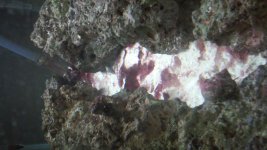I have a cyano bacteria problem.
I read from a article about this today on this forum that nutrient control is really important.
Two main questions I have.
Well to ask the first one, you should know that I began feeding my new juvenile red maroon clownfish twice a day, because it always and still seems to eat anything I give it (be it flake food, it didn't like frozen for @#$%.)
So I stopped this practice, and now I only feed it once a day. Yet I am still concerned I might be feeding it too much, even though I expanded my cleaner crew from 9 to 12 the other day, and I expect whatever leftovers will be eaten by the cleaner crew.
So my first question is how do you really measure a pinch of flake food?
Do you use any special tools to measure exactly how much is appropriate for one meal period that will be it's only food for 24 hours?
Second question
I am wondering instead of doing water changes for awhile (or less so) as this adds in new nutrients into the water, instead I just start syphoning the water near where the cyano is growing specifically and then just gradually do it to all the water in my aquarium using a filter sock, and then gradually putting this modified water back into my aquarium?
Here is a picture of my tank today (right now).
I read from a article about this today on this forum that nutrient control is really important.
Two main questions I have.
Well to ask the first one, you should know that I began feeding my new juvenile red maroon clownfish twice a day, because it always and still seems to eat anything I give it (be it flake food, it didn't like frozen for @#$%.)
So I stopped this practice, and now I only feed it once a day. Yet I am still concerned I might be feeding it too much, even though I expanded my cleaner crew from 9 to 12 the other day, and I expect whatever leftovers will be eaten by the cleaner crew.
So my first question is how do you really measure a pinch of flake food?
Do you use any special tools to measure exactly how much is appropriate for one meal period that will be it's only food for 24 hours?
Second question
I am wondering instead of doing water changes for awhile (or less so) as this adds in new nutrients into the water, instead I just start syphoning the water near where the cyano is growing specifically and then just gradually do it to all the water in my aquarium using a filter sock, and then gradually putting this modified water back into my aquarium?
Here is a picture of my tank today (right now).






